
Forensic entomology is an science study of colonization of a dead body by arthropods. This includes the study of insect types commonly associated with cadavers, their respective life cycles, their ecological presences in a given environment, as well as the changes in insect assemblage with the progression of decomposition. Insect succession patterns are identified based on the time a given species of insect spends in a given developmental stage, and how many generations have been produced since the insects introduction to a given food source. Insect development alongside environmental data such as temperature and vapor density, can be used to estimate the time since death, due to the fact that flying insects are attracted to a body immediately after death. The identification of postmortem interval to aid in death investigations is the primary scope of this scientific field. However, forensic entomology is not limited to homicides, it has also been used in cases of neglect and abuse, in toxicology contexts to detect the presence of drugs, and in dry shelf food contamination incidents. Equally, insect assemblages present on a body, can be used to approximate a given location, as certain insects may be unique to certain areas. Therefore, forensic entomology can be divided into three subfields: urban, stored-product and medico-legal/medico-criminal entomology.

Silphidae is a family of beetles that are known commonly as large carrion beetles, carrion beetles or burying beetles. There are two subfamilies: Silphinae and Nicrophorinae. Members of Nicrophorinae are sometimes known as burying beetles or sexton beetles. The number of species is relatively small, at around two hundred. They are more diverse in the temperate region although a few tropical endemics are known. Both subfamilies feed on decaying organic matter such as dead animals. The subfamilies differ in which uses parental care and which types of carcasses they prefer. Silphidae are considered to be of importance to forensic entomologists because when they are found on a decaying body they are used to help estimate a post-mortem interval.

Histeridae is a family of beetles commonly known as clown beetles or hister beetles. This very diverse group of beetles contains 3,900 species found worldwide. They can be easily identified by their shortened elytra that leaves two of the seven tergites exposed, and their geniculate (elbowed) antennae with clubbed ends. These predatory feeders are most active at night and will fake death if they feel threatened. This family of beetles will occupy almost any kind of niche throughout the world. Hister beetles have proved useful during forensic investigations to help in time of death estimation. Also, certain species are used in the control of livestock pests that infest dung and to control houseflies. Because they are predacious and will even eat other hister beetles, they must be isolated when collected.
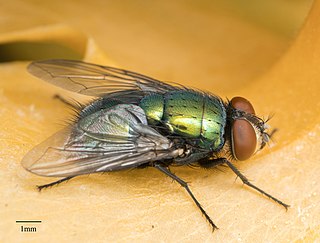
The common green bottle fly is a blowfly found in most areas of the world and is the most well-known of the numerous green bottle fly species. Its body is 10–14 mm (0.39–0.55 in) in length – slightly larger than a house fly – and has brilliant, metallic, blue-green or golden coloration with black markings. It has short, sparse, black bristles (setae) and three cross-grooves on the thorax. The wings are clear with light brown veins, and the legs and antennae are black. The larvae of the fly may be used for maggot therapy, are commonly used in forensic entomology, and can be the cause of myiasis in livestock and pets. The common green bottle fly emerges in the spring for mating.
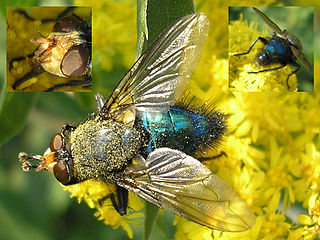
Cynomya mortuorum belongs to the order Diptera, sometimes referred to as "true flies". In English, the only common name occasionally used is "fly of the dead". It has a bluish-green appearance, similar to other Calliphoridae and is found in multiple geographic locations with a preference for colder regions. Belonging to the family Calliphoridae, it has been shown to have forensically relevant implications due to its appearance on carrion. Current research is being done to determine C. mortuorum's level of importance and usage within forensic entomology.

Calliphora vomitoria, known as the blue bottle fly, orange-bearded blue bottle, or bottlebee, is a species of blow fly, a species in the family Calliphoridae. Calliphora vomitoria is the type species of the genus Calliphora. It is common throughout many continents including Europe, Americas, and Africa. They are fairly large flies, nearly twice the size of the housefly, with a metallic blue abdomen and long orange setae on the gena.
Forensic entomological decomposition is how insects decompose and what that means for timing and information in criminal investigations. Medicolegal entomology is a branch of forensic entomology that applies the study of insects to criminal investigations, and is commonly used in death investigations for estimating the post-mortem interval (PMI). One method of obtaining this estimate uses the time and pattern of arthropod colonization. This method will provide an estimation of the period of insect activity, which may or may not correlate exactly with the time of death. While insect successional data may not provide as accurate an estimate during the early stages of decomposition as developmental data, it is applicable for later decompositional stages and can be accurate for periods up to a few years.

Lucilia illustris is a member of the fly family Calliphoridae, commonly known as a blow fly. Along with several other species, L. illustris is commonly referred to as a green bottle fly. Lucilia illustris is typically 6–9 mm in length and has a metallic blue-green thorax. The larvae develop in three instars, each with unique developmental properties. The adult fly typically will feed on flowers, but the females need some sort of carrion protein in order to breed and lay eggs.

Phormia regina, the black blow fly, belongs to the blow fly family Calliphoridae and was first described by Johann Wilhelm Meigen.
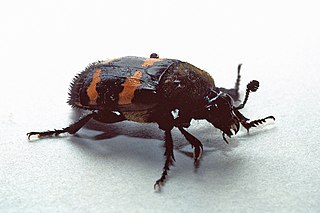
Nicrophorus tomentosus is a species of burying beetle that was described by Friedrich Weber in 1801. The beetle belongs to the family Silphidae which are carrion beetles. The beetles have sensitive antennae that contain olfactory organs. Thus, the beetle can locate dead animals (carcass), and then as the name suggests, can bury them. However, unlike other burying beetles, N. tomentosus does not completely bury these brood carcasses. They instead dig a shallow hole under the carcass and cover it with leaf litter. Recognition of these beetles can be distinguished by its black color with orange markings on the wing covers (elytra).
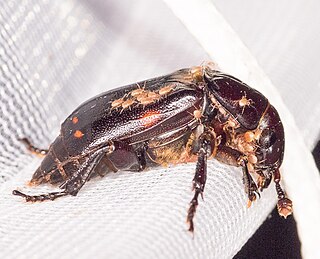
Nicrophorus pustulatus, also known as the pustulated carrion beetle or blistered burying beetle, is a species of burying beetle that was described by Johann Karl Wilhelm Illiger in 1807. This species is native to North America. N. pustulatus exhibits unique habitat utilization and breeding behaviour relative to other members of the genus. This species may be the only described example of a true parasitoid targeting a vertebrate host.

Nicrophorus quadripunctatus is a species of burying beetle that predominates in East Asia. First described by German entomologist Ernst Kraatz in 1877, this beetle has since been the subject of much scientific inquiry—particularly concerning its parental care. Like other burying beetles, N. quadripunctatus inhabit small, vertebrate animal carcasses. This environment provides the beetles with the requisite nutrients for themselves and their offspring. To limit resource theft and predation, the carcass is buried underground. For additional protection, a single, dominant male-female pair guards the carcass cooperatively.

Nicrophorus orbicollis is a nearctic burying beetle first described by Thomas Say in 1825. It is a member of the genus Nicrophorus or sexton beetles, comprising the most common beetles in the family Silphidae. This species is a decomposer feeding on carcasses of small dead animals. N. orbicollis can be used for scientific research both medically and forensically.

The American carrion beetle is a North American beetle of the family Silphidae. It lays its eggs in, and its larvae consume, raw flesh and fungi. The larvae and adults also consume fly larvae and the larvae of other carrion beetles that compete for the same food sources as its larvae.
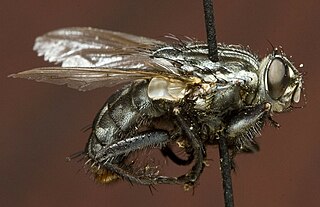
Sarcophaga bullata, or the grey flesh fly, is a species of fly belonging to the family Sarcophagidae. It varies in size from small to large, 8 to 17 millimeters in length and is very similar in appearance and behavior to a closely related species, Sarcophaga haemorrhoidalis. S. bullata is a common scavenger species in the Eastern United States, but is found throughout the Nearctic region. Identification down to the species level in the family Sarcophagidae is notably difficult and relies primarily on the male genitalia. Though limited information is available regarding S. bullata, it has gained increasing recognition in the field of forensic entomology as a forensically relevant fly species, as it may be among the first species to colonize human remains. In these instances, recovered maggots may be analyzed for post-mortem interval (PMI) estimations, which may be used as evidence in courts of law. Current studies regarding S. bullata have revealed a maternal effect operating in these flies that prevents pupal diapause under certain environmental conditions, which is an important factor to be considered during forensic analyses.
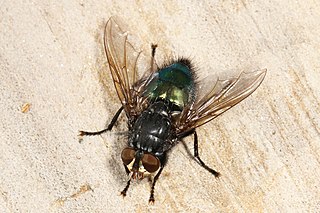
Cynomya cadaverina, also known as the shiny blue bottle fly, is a member of the family Calliphoridae, which includes blow flies as well as bottle flies. In recent years, this family has become a forensically important facet in many medicocriminal investigations in the growing field of forensic entomology. C. cadaverina is specifically important in determining a post-mortem interval, as well as other important factors.

Lucilia coeruleiviridis, formerly Phaenecia coeruleiviridis, is commonly known as a green bottle fly, because of its metallic blue-green thorax and abdomen. L. coeruleiviridis was first discovered by French entomologist Pierre-Justin-Marie Macquart in 1855. It belongs to the family Calliphoridae and is one of many forensically important Diptera, as it is often found on decaying substances. L. coeruleiviridis is one of the most ubiquitous blow fly species in the southeastern United States, particularly in the spring and fall months.

Oiceoptoma noveboracense is a member of the family Silphidae, or carrion beetles, which feed on decaying organic matter such as dead animals. Its common name is the margined carrion beetle, from the orange-red margins on the pronotum, which are helpful when identifying this species. The larva is typically light brown to red and also has vertical ridges on its thorax like the adult. This diurnal beetle can be found mainly in the spring into the fall, and it has a strong preference towards a deciduous forest habitat. The primary forensic importance of this beetle is its ability to use the succession of insect fauna to provide confirmation of postmortem intervals.
Calliphora loewi is part of the family Calliphoridae, bottle flies and blowflies, and in the genus Calliphora, blue bottle flies. The genus can be deceiving since C. loewi is not blue. Though this species is rare, it can play an important part in forensic entomology, spreading disease, and decomposing carrion. The life cycle of C. loewi is similar to the life cycle of the genus Calliphora. Since this species is rare there has not been very much research done with this species.
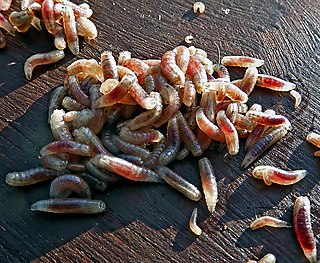
Carrion insects are insects associated with decomposing remains. The processes of decomposition begin within a few minutes of death. Decomposing remains offer a temporary, changing site of concentrated resources which are exploited by a wide range of organisms, of which arthropods are often the first to arrive and the predominant exploitive group. However, not all arthropods found on or near decomposing remains will have an active role in the decay process.


















